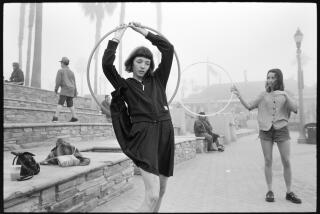What he really thought
- Share via
Like his contemporary Noel Coward, Cecil Beaton was that peculiarly British 20th century phenomenon, a man from relatively meager social origins who utterly reinvented himself in the image of those he aspired to. Rejecting his middle-class family’s timber business, he set about scaling the social heights of British high society in the 1920s.
Throughout the next five decades, he maintained his position as one of the most sought-after portrait and fashion photographers in the world, and his pictures of Hollywood stars, artists, writers and social leaders became classic images. Also in those years, he was a prolific keeper of diaries.
During his life, Beaton, who died in 1980 at 76, published six discreetly self-censored volumes of them.
It is only now, with the publication in the United Kingdom of “The Unexpurgated Beaton” (Weidenfeld & Nicholson), that the public can read some of the less flattering portraits of the glitterati with whom he mixed. Edited by Beaton biographer Hugo Vickers, the new book covers the last decade of his life, when he remained as active and involved as ever with the social, arts and show-biz scenes around him.
Although he was an avid admirer of those who, like him, had reached the top of their field, the new book reveals that far from being star-struck, the photographer could be ruthless in his judgments of his rich and famous subjects, from Elizabeth Taylor’s skin to Salvador Dali’s bad breath.
Photographing Elizabeth Taylor at a grand ball for Vogue in 1969, he wrote: “Her breasts, hanging and huge, were like those of a peasant woman sucking her young in Peru. They were seen in full shape, blotched and mauve, plum ... on her fat, coarse hands more of the biggest diamonds and emeralds.... In comparison everyone else looked ladylike.’
That same year, working in New York on a new musical about Coco Chanel, he had this to say about its star, Katharine Hepburn:
“That beautiful bone structure of cheekbone, nose and chin goes for nothing in its surrounding flesh of the New England shopkeeper. She has no generosity, no heart, no grace.”
He was even more scathing about the erstwhile Hollywood sex goddess Mae West, whom he photographed for the release of her movie “Myra Breckinridge” in 1971.
“She could hardly be considered human,” he wrote in his diary.
“The neck, cheeks and shoulders were hidden beneath a peroxide wig. The muzzle, which was all one could see of the face, with the pretty capped teeth, was like that of a nice little ape.”
Beaton’s friendship with England’s royals didn’t spare them his sharp tongue.
He wrote of an occasion when he came across Princess Margaret at a party: “Gosh the shock! The flesh is solid and I don’t think dieting can reduce a marble statue.”
At another event, he describes the Duchess of Windsor -- the American Wallis Simpson -- as behaving “like a mad Goya. She is more than ever a personality and character, but God, what she looks like, her face so pulled up that her mouth stretches from ear to ear.”
More to Read
Sign up for our Book Club newsletter
Get the latest news, events and more from the Los Angeles Times Book Club, and help us get L.A. reading and talking.
You may occasionally receive promotional content from the Los Angeles Times.








